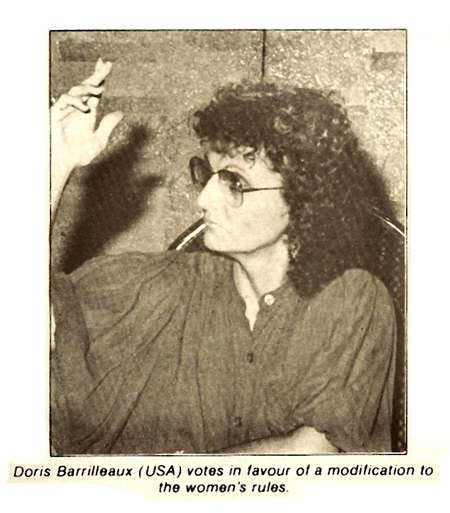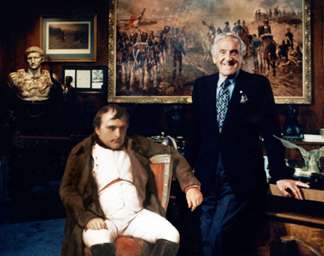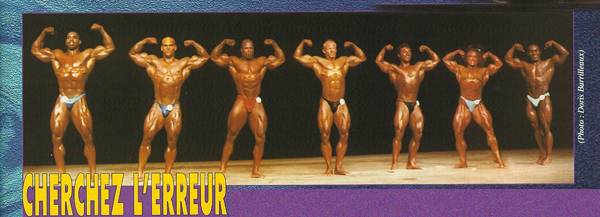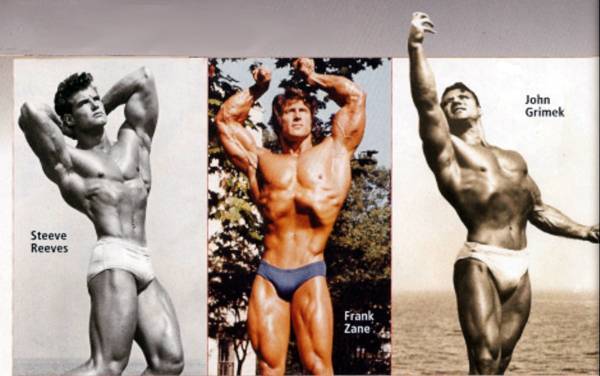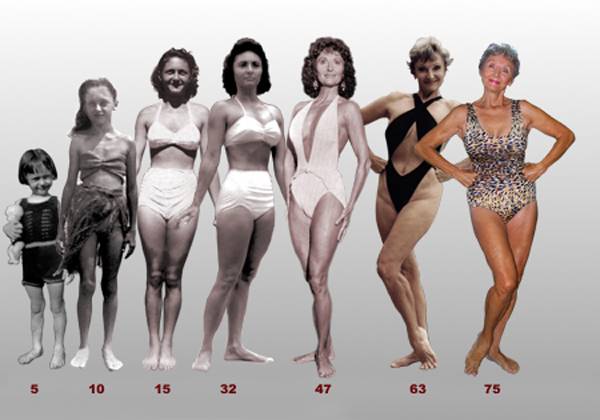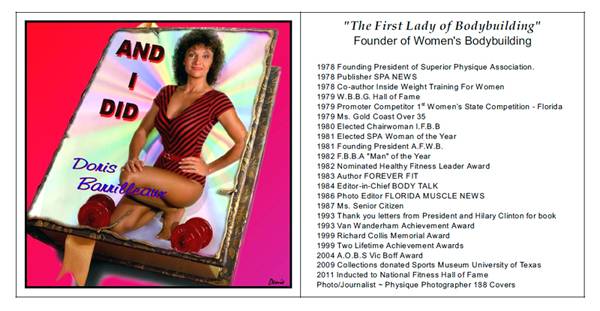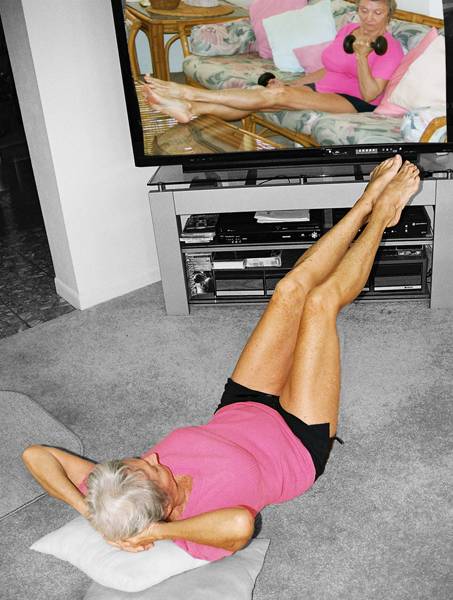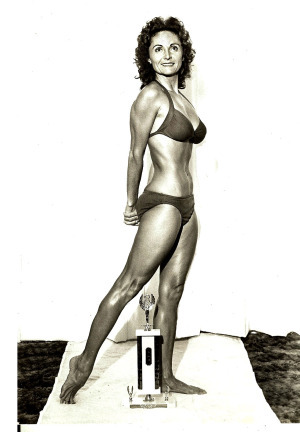
Doris Jean Barrilleaux is a woman that could rightfully claim that role. Already a grandmother at age 36, she was there when modern female bodybuilding came into existence. Perhaps due to her maturity, as well as her unique dynamic personality, she was not only a competitor, but also an organizer, a promoter, a publisher, an author, an administrator, a judge, a photographer, and most importantly one of the philosophical leaders of this new activity called female bodybuilding.
Her significant influence guided female bodybuilding during its baby steps. She had a clear view on her mind on how women’s bodybuilding should be governed, judged, and look like. After following men’s bodybuilding contests for many years and competing herself in the very first pageant-like athletic female contests of the time, she took matters into her own hands and organized one of the first serious female bodybuilding contests in the US (the first one in Florida), the 1979 Ms. Brandon Physique. She was elected IFBB Women’s Representative in 1980, and head-judged in a Ms. Olympia contest for the first time in 1981. An eloquent writer in books and in bodybuilding magazines as well as a successful physique photographer for many years, Doris Barrilleaux has an enviable archive of thousands of photos covering most of the ’70s, ’80s and ’90s.
During the early ’80s, Doris worked with Ben Weider and Oscar State, trying to set the proper framework for the acceptance of female bodybuilding. She fought for the right of women to govern their own sport and she was a huge fan of the aesthetic and more feminine appearance of female bodybuilders. Those very views that turned female bodybuilding from a beauty pageant into a well-organized and independent branch of bodybuilding, those very views had her eventually marginalized from this same sport.

Doris Barrilleaux will become 82 years of age this summer. She is still a very active person, both physically and mentally. She bikes every day, and she posts on her Facebook profile daily little gems about bodybuilding history, extracted from her huge archive. A sample of these can be found in her DVD “And I Did!“, Vol.1, and she is currently busy preparing Vol. 2
We contacted her and she agreed to give the following interview to us. As many of you understand, this is not your usual type of interview. It is a real joy for the bodybuilding enthusiast to talk with someone like Doris. She radiates so much energy, even via usual email messages. She has interesting and unheard stories to tell for just about everything bodybuilding-related, and provide rare photographic material to prove her point. This makes it twice as difficult for us to pick questions to ask, if we could, we would ask a million of them! Nevertheless, I have tried to condense the interview in three parts, more or less in a timeline fashion.
In the first part of the interview to XBody.gr, Doris Barrilleaux talks a bit about her personal life and its relation to bodybuilding. How she started lifting, what were her influences, etc. Then we get into the interesting 1978-1979, when female bodybuilding emerged into existence as we know it today. And who better to convey the “atmosphere” of that fascinating period of time, than the woman who was essentially leading the female bodybuilding movement. Enjoy!
On personal life related to bodybuilding
GRF: Dear Ms. Barrilleaux, it is our honor and pleasure to have this conversation with you, we would like to thank you very much for your time. Let me start this interview by asking you when and where did you start lifting weights? Please tell us how you first joined your first gym.
DJB: It was after the birth of my 4th of 5 children that was born in 1955. He was 9lb 4oz and after taking the 3 younger ones to a play ground 3 weeks later, I was shocked to find that I lacked the strength to hang by my knees on the trapeze. I knew I had to do something to get back my strength. I picked up magazines Strength & Health and Muscular Development, bought some 10 & 15 pound weights and began working out as shown in the men’s magazines. I then got the idea of joining a gym. I had never heard of a woman in a gym and called a number of times before I ventured into one. There, behind a curtain was a handful of women with small weights being trained by the gym owner’s wife. I continued reading the magazines and even got my husband interested in weight training.
There was a single column for women by Vera Christenson for the Ladies. I sent her a double biceps photo posed as I’d seen the men do. She returned it asking for a more feminine pose!

I took another sitting and it was published along with my children in the magazine in 1963.
GRF: You grew up in a time where there was practically no “fitness” or “bodybuilding” for women. What were your role models at the time?
DJB: I was born in 1931. The first Johnny Weissmueller movie “Tarzan The Ape Man” was produced in 1932. Perhaps my love of the jungle stems from my dad taking me to the circus with the wild animals. I even have an ancient photo of my maternal grandmother sitting on an elephant in Europe. As a little girl, I always played that I was, Sheena – Queen of the Jungle and was always climbing trees. In grade school, I preferred to play the physical games with the boys rather than with the girls. As a teen, I loved the old movies about the tropics as well as the jungle. Actress, Esther Williams, as a swimmer had a beautiful, athlete body with broad shoulders that I admired. There were also dancers, Cyd Charisse and Vera Ellen, with gorgeous bodies and beautiful shapely legs. In high school, my favorite classes were Art and Physical Education with volleyball, baseball and basketball played in gym class.
Between the ages 18-28, I had 5 children. There was no time for sports, but I took care of the yard, grew my own vegetables, painted the house inside and out, and bowled for sport. I once hired help with the weekly 30 white starched shirts to iron plus clean the house, until I realized that for the $6 I paid the woman I could afford to bowl three leagues a week, so I joined a forth. In 1961, I won the Halloween prize at the bowling alley for a jungle costume I made. Over the years they became more elaborate. Also won prize in 2008.

I even restored a 1954 Corvette by myself. Repairing the fiberglass fender, repairing the floorboard and carpeting it. It was the first time I used a paint sprayer and was so proud there was not a run nor orange peel on it, nor the hard top. So you might say that I’ve never been sedentary. In 2002, while sitting in a restaurant, Lou Ferrigno, admitted to me me that, Johnny Weissmueller, was his first inspiration as well. Photo is us 20 yrs apart. 30 & 50 and 50 & 70.

GRF: Could you tell us in a few words what was your diet and training like at the time and where you had obtained that information from? Were there any supplements around at the time and did you use any?
DJB: This is the question that I always dread! My diet was a normal American diet and I was always very active. My weight always remained at 125 at 5’4″ ft. When I decided to enter that first bodybuilding contest only three weeks away in Canton, OH in 1978, I wanted to drop a few pounds. I knew nothing about diet. As I live on the river, for the three weeks prior to the show, I ate boiled blue crabs and yogurt, for no particular reason. I was shocked when I returned home and discovered I only weighed 116. I immediately set up my camera and tripod in the bedroom, hung flash on the closet door, jumped across the double bed, and hit this black & white triceps pose that to this day is used worldwide.

I recall once my husband chiding me for lying on the floor watching TV and eating ice cream. I replied, “Yes, but I’m doing leg raises at the same time and you’re just lying there”. Never in my life have I counted a calorie nor carb. Once I became so involved in bodybuilding, I was constantly around the top pro and amateur male competitors so I just learned by osmosis. I also reported on their seminars for the various magazines.
Perhaps, I have a good metabolism as well as good sense. Today, if I go a couple pounds over my preferred 123, I back off for a few days, or increase my five-mile-a-day bike ride. Before taking a 54 day cruise around South America in 1998, I decided to lose extra pounds fully aware of the amount of food consumed at sea. I actually lost more than planned and became concerned when it continued to drop the first few days. I was able to enjoy the cruise and only gained back five pounds. I made a “Photoshopped” 8×10 to hang inside my cabin door as a reminder each time I left the cabin. I gave two slide show/seminars that were very well received.
While on dead heads as a flight attendant, I wrote Forever Fit. After publishing my book, I produced my own vitamin line called Forever Fit. I had no way to promote it, nor could I compete with the drug store chains.


As for my training, we had a home gym with enough equipment for both my husband and myself.
On beginnings of competitive bodybuilding
GRF: In 1978 you competed in McGhee’s First National Physique Championship. Please tell us a bit about your first time on stage, the way you were judged and how that led you to organize in April 1979, (and also competed) in the first-ever female bodybuilding contest in Florida, and probably the first competitively organized contest in the USA that resembles today’s contests, the Ms. Brandon Physique 1979. I read that in the latter contest there were 13 competitors, that was great for such an initial step. What exactly was the venue of the contest? How did you advertise the event and what had been the athletic background of all these women since there were practically no previous contests of these type, other than the ones organized by Henry McGhee? Who were the judges and is it true that after you competed yourself, you cooked for all the competitors?
DJB: When I read in a 1977 Muscular Development about something billed as a Women’s Bodybuilding contest scheduled by Henry McGhee at the Canton, OH YMCA, I immediately contacted, John Grimek, my idol at the time.

Both he and Henry McGhee encouraged me to enter. With only three weeks to prepare, I did. Henry made a gallant attempt, but apparently lacked the experience of running a contest. Perhaps I had attended more than he. It was a surprise when he required us to wear sweat tops to judge the lower body, and sweat pants to judge the upper. Naturally his judges had no experience, so he perched on their table and explained what to look for.

I was terrified. Even in school, I could only look at the teacher and not the class when giving a report. Here I was, 46 in a two-piece bathing suit, on stage with all the women half my age, in a strange town, in front of an audience. My whole body shook. In my class 1st place was 22 and 2nd was 17, I was 3rd!

Back stage there was utter chaos. I knew that I could run a better organized contest. But I give Henry credit for trying to start something. Soon as I returned home, I was asked to Guest Pose at major upcoming men’s contest. Afterward, Suzanne Kosack, approached me and asked why we couldn’t have something like that for women. I gathered a group of local women and we were on our way. On April 29, 1979 my Superior Physique Association sponsored and held The Ms. Brandon Physique competition after a local men’s contest.

We had 13 contestants. One woman jogged 13 miles to enter! Another came from Louisiana. We were all surprised when, Laura Combes appeared as the most muscular woman any of us had ever seen, and thus the controversy began. The contest flowed flawlessly and we had a celebration party following.


The media was quite receptive and I was touted as being a Bodybuilding Grandmother appearing in many newspapers and magazines ever since. The thing that really catapulted us into the spotlight was when I contacted the highly popular TV program Real People. They sent a crew to Tampa to film our Ms Tampa Physique and women’s bodybuilding was on the way. But not without years of struggle to be accepted.
Our SPA rules called for a majority of women judges, 4 women and 3 men for obvious reasons. Two of the male judges were competitors and Guest Poser, Richard Baldwin and Peter Potter, now Vice President of the NPC. I honestly can’t remember the females. Perhaps because I was also competing, helping the inexperienced female emcee, and had cooked for a big celebration party following.
Our rules soon fell by the wayside as there were too few women for judges. Now, occasionally I may see a “token” female judge on the panel. I became a National and International judge for the men.
GRF: After the Ms. Brandon Physique 1979, many other contests emerged around the US during that year, probably a very famous one being the first IFBB Women’s World Pro Bodybuilding Championship in Los Angeles, CA on June 16, 1979, won by Lisa Lyon. I know that you could not attend that particular contest, but you organized a significant number of contests during that year with the Superior Physique Association. I would like you to convey to us the “atmosphere” that was evolving during that year, it was a new thing and you, of all people, were not just a lucky (or should I say competent) witness, you were actually “creating” the sport. Tell us a bit about the reactions that you got from women who contacted you and were interested in competing, as well as the crowd and media reactions during those first contests.
DJB: Two months after we held the first SPA contest in Brandon, FL, Lisa Lyon won the first IFBB Women’s World Pro Bodybuilding Championship in June, 1979 in California. She also sponsored the United States Women’s Bodybuilding Competition (USWBBC) in Atlantic City. She was the IFBB Women’s Representative until I was elected to replace her at the 1980 IFBB International Congress in Manila.

Once we appeared on the Real People TV show the news of our new organization spread like wildfire. Both men and women contacted me very excited about the new concept. Most of the media was very favorable, but a few made a joke of it or were downright against such a thing. At that point very few women had a desire to emulate the male bodybuilders. We just wanted to be recognized for sculpting our bodies and showing the great health benefits of weight training. My idea of athletic and fit women were the athletes, swimmers, and gymnasts. Although actress Marilyn Monroe was known to use weights she had the soft, round, voluptuous pin-up figure. I attended a male competition in New Orleans one year that also had a women’s contest even before starting SPA. There was one particularly attractive, well toned and tanned young woman that I was certain to be the winner hands down. I was so disappointed that the male judges picked the Marilyn Monroe type!
We had our own discrepancies to deal with. Some judges picked a very lean and ripped woman, others picked one with masculine lines, and being mostly male judges some the most sexy.
In 2010, Steve Wennerstrom, IFBB Women’s Historian published on-line a wonderfully accurate article on the history of the women’s State Bodybuilding Championships. He stated, “One element was certain, Doris Barrilleaux and her fledgling SPA organization had jump-started a state-wide contest that has run continuously to this day – the longest running state contest in the country.”.
Bill Dobbins, from Muscle & Fitness published “Muscle amid the magnolias”, a 10-page article covering our Ms. Florida Physique.
In the 1st part of the XBody.gr interview with legendary women’s bodybuilding pioneer Doris Barrilleaux, we found out how she got started into bodybuilding, her first contests in the late 1970s as a competitor and then as a promoter, and her determination to organize women’s bodybuilding as an independent and self-governed bodybuilding branch.
Continuing on to the 2nd part (out of a total of 3), we move on to the early 1980s, a period of time where Doris Barrilleaux was highly active in the IFBB. She offers us some exciting stories from that time along with rare photographic material. She was elected Women’s Representative in 1980 and head-judged Ms. Olympia 1981. Within the IFBB, she formed the American Federation of Women Bodybuilders (AFWB) which absorbed her SPA organization, but was absorbed eventually by the NPC. She talks to us about being a judge, the obsolete Mixed Pairs category, and she outlines for us the politics of the time within the IFBB leading to her departure from the Federation in 1984. Finally, some interesting facts about the famous Pumping Iron II: The Women 1985 movie are mentioned.
The IFBB era, on being a judge and on politics
GRF: What was the 1st Ms. Olympia that you judged? What do you remember about the competitors? With so many body types out there, did it ever became hard for you to be a judge or did you always have a clear picture on your mind about how you’d expect a competitor to be?
DJB: Rachel McLish, the unknown beauty from Harlingen, Texas won the first Miss Olympia in 1980 and again in 1982. The first one that I Head Judged was 1981 when, Kike Elomaa, from Finland took the title.
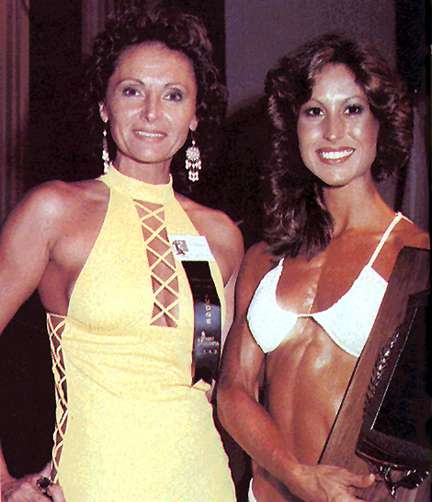
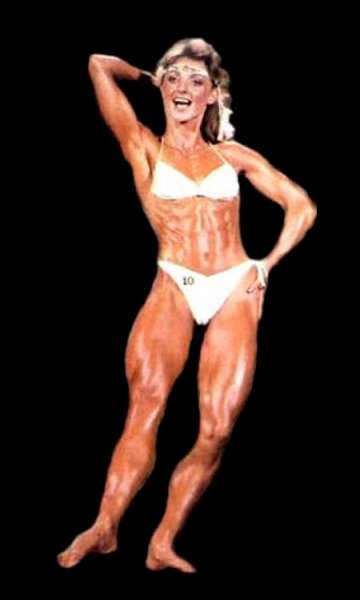
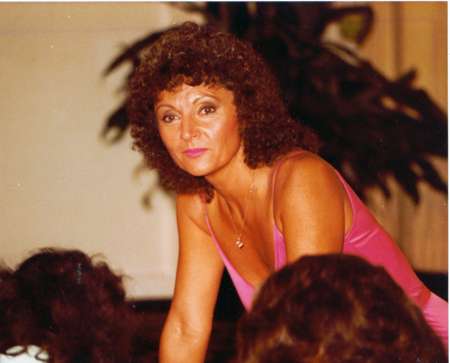
At that time we used a 20 point system to judge the three rounds, Symmetry, Muscularity and Presentation. A sample of the early score sheets is shown.
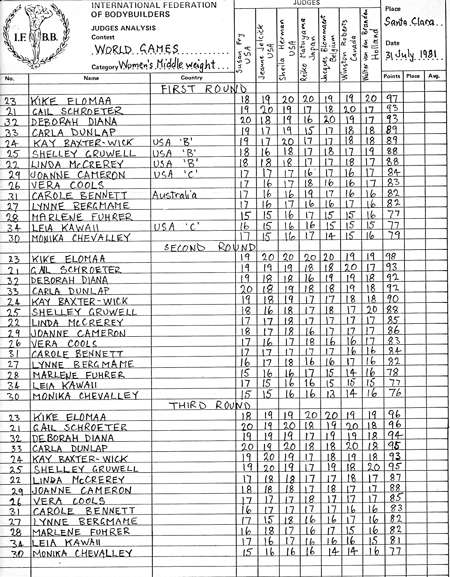
We soon divided into two classes, Lightweight and Middleweight. There was no way to predict the outcome determined by the total points. A well developed figure with mediocre posing could lose to someone with a great routine but very little development. We found this system far more complicated than just placing the contestant. My last involvement with the Olympia was in 1984 as co-emcee with, Joe Tete. I have no knowledge what the current judging system is today.
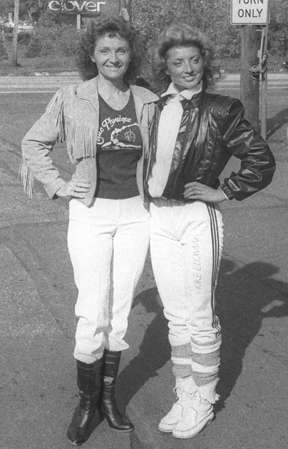
GRF: Do you remember any funny incident during your career as an IFBB judge?
DJB: One incident that a whole group considered funny happened in Europe in the early 1980’s. There was one individual working for a magazine who was disliked by everyone. If you said snow was white, he’d argue that it was black. If you said coal was black, he’d insist it was white. There was a caravan of several cars loaded with all the judges and officials at the curb ready to head for the contest venue. As he came down the walk, every single car rolled up their windows and locked the doors. He tried unsuccessfully to get in one. The caravan left without him.
Another incident was when we used the large score cards held up for both the competitors and audience to see your vote. This International IFBB contest had 17 contestants. I was the only female judge on the panel. My only discrepancy was placing #16 as 17th, and #17 as 16th. All the rest were right on. As if it really made that much difference at the bottom. That night as Winston Roberts, Vice President of the IFBB, and I were having dinner this one competitor # 16 walked up to our table and shook his finger at me saying, “You go back you kitchen!”. That was the wrong time and place to insult me sitting with Winston in the restaurant. He was from one of those countries that held women in low esteem. I heard he had been banned from competing for a year. Some time later when, Joe Weider, was dropping me at Gold’s Gym in Los Angeles, who but #16 came running out to kiss my hand?
This was not funny, but an incident I don’t like to remember when the airline lost my luggage containing all my clothes and camera equipment upon arrival in Cairo, Egypt. I filled out the forms indicating that we were staying at the Holiday Inn Giza, near the pyramids. I’d worn a nice red and white sweat suit for the long flight from Florida.
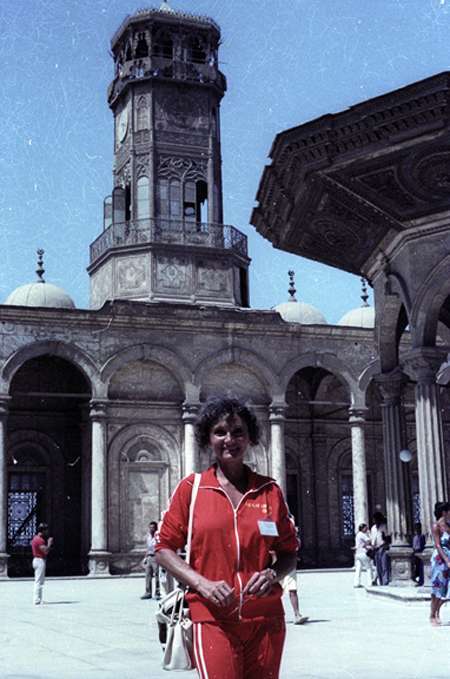
Marsha Manion, loaned me a single outfit to wear at the functions over the five days we were there for the Mr. Universe competition and IFBB International Congress.

Every morning I called the airport to check on my baggage. The day before we left I took a taxi to check in person. As I entered the lobby, there sitting alone in the middle of the old wooden floor stood my large yellow suitcase that had been sitting there since the night of my arrival. I asked why no one notified me. The reply was, “We didn’t know the number for the hotel.” Well, I surely didn’t know it upon arrival. Needless to say I missed photographing the Mr. Universe competition and contestants posing near the Sphinx.
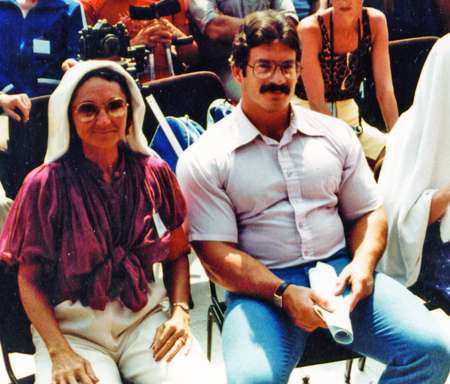
GRF: There was a short-lived Mixed Pairs class, what was your opinion about that and why was it abolished?
DJB: Our SPA Association initiated the “Couples” competition which was quickly renamed “Mixed Pairs” to indicate a male and a female (I vaguely remember that I once I saw the Mentzer brothers pose together, but not sure I have any photos to verify that). Once the women entered the bodybuilding scene, and the media took such interest, suddenly the men loosened up and became much better posers. Apparently, following the women’s example, they no longer felt limited only to the their few compulsory poses. The best posers of that era were Frank Zane and Ed Corney who developed their own styles.
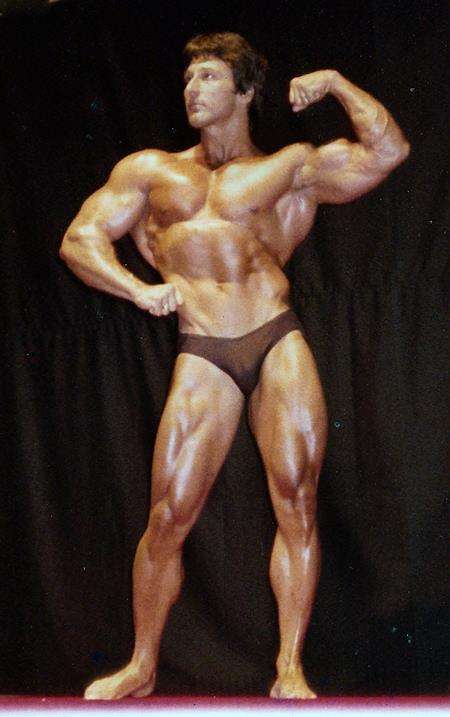
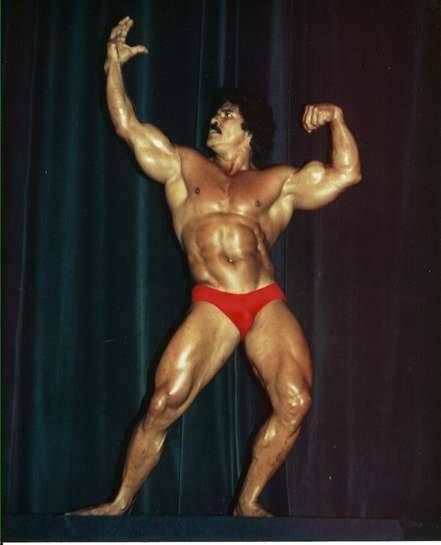
The mixed pairs were very well received as they each developed unique and artistic routines. The couples seemed to enjoy their posing as much as did the audience. Many of the top male and female bodybuilders appeared to enjoyed this art form. Just to name a few, Shelly Gruwell & Tony Pearson, Boyer & Valerie Coe, Carla Dunlap & John Kemper, and Cory & Jeff Everson.
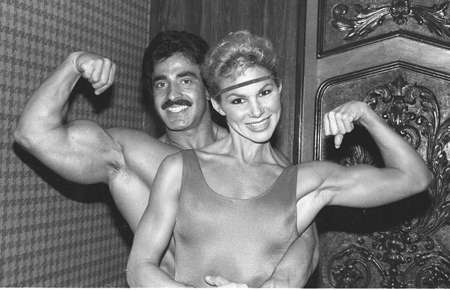
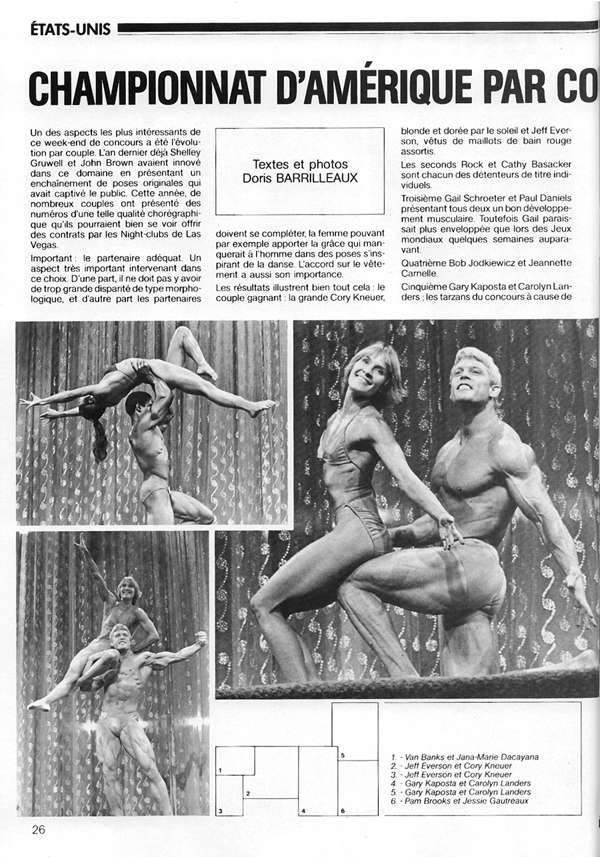
I photographed many beautiful couples’ routines, and included them in my SPA Posing Guide to help the newer couples. I can only speculate that as the men took control of the women’s sport around 1984, this class of competition fell by the wayside. Personally, I think this was a very big mistake.

GRF: When you were essentially marginalized in the IFBB and left AFWB in 1982, did you ever think of reviving the already successful SPA and why eventually did it never happen? Would you have taken the same decision today?
DJB: Let me give you a quote from Susan Fry, who was Secretary of the AFWB, and the General Secretary of the IFBB Women’s Committee. She also worked in Joe Weider’s office for Muscle & Fitness. She once asked me, “Doris, do you ever feel like you’re running down the field carrying the flag, and when you turn around, there’s no one behind you?”. I couldn’t have put it better myself.
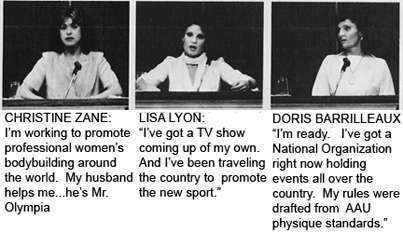
After Ben Weider asked me to form an amateur federation for the women competitors, while I was Chairwoman of the IFBB Women’s Committee, I just let my SPA organization become absorbed by the AFWB. I never expected that after all we went through setting up the American Federation of Women Bodybuilders, which Ben even helped me name, that we’d suddenly be told it was illegal to have two different federations. Didn’t he know this at the time? We would communicate by phone several times a day. I wanted to give the women a chance to vote, but that didn’t happen; we were taken under the cover of the National Physique Committee, large bank account and all. As the single female on the 13 member Board of Directors of the IFBB, my vote carried little influence, but at least I had a vote there. I’d once been warned from one of the bodybuilding legends, “If you ever cross Ben, he’ll drop you like a hot potato”. He was right.
I welcomed all the help and guidance given the men, especially Oscar State, who had so much experience. I loved the little man. He stuck to the rules but always was fair. I considered him the backbone of the IFBB. He was the only person I ever heard tell Ben when he knew he was wrong. There was one thing that upset me. During the year, I received all the complaints from the professional women. I would schedule a meeting at the next pro show to discuss them. But at every meeting, Oscar and Wayne Demilia, would infiltrate our meeting as observers. Now, they were the ones who picked the pro competitors to invite. Not a single woman would speak up when I tried to address their concerns. As one told me, they were afraid if they complained, they would not be invited to the next contest. Toward the end of my involvement one official told me, “We’ve got the only game in town, you play it our way or you don’t play”. I stood for at least letting the women vote whether to attempt continuing on our own or not. This did not sit well with Ben and he then completely ignored me after that. 1984 was the last year I served on the Women’s Committee. When Oscar died in 1984, I felt that the professional bodybuilders lost their mentor, and the women lost their greatest ally.
The next contact I had with Ben was in 2001. I enjoyed working with Photoshop, and knowing his obsession with Napoleon, and seeing all the artifacts in his home, I sent him a little composite I made.
In a reply, he wrote this excerpt: “The picture of Napoleon in the chair is great. I would appreciate it if you could please make 12 copies. Please let me know the cost and I will promptly reimburse you. Best regards, Ben”. I sent his copies but ignored the offer of payment. Ben died in 2008. At one point Joe Weider asked me for a copy of the picture.
I never considered resurrecting SPA, I had given enough of my life to the struggle to initiate and organize women’s bodybuilding. I stayed within the sport photographing competitions and providing pictures to them and magazines. I was also Photo Editor of Florida Muscle News, a magazine dedicated to the State. I expected to be at this until I reached 80. But the digital camera came along and so did many other photographers. I stopped shooting the shows in 2004.
During all this time there were certain men who believed that they should control the women’s sport, not the women themselves. But that’s another story.
GRF: The movie “Pumping Iron II : the Women” was the sequel to the original Pumping Iron. What is your take on the movie, and why did you only have a very small role in it?
DJB: By the time the movie Pumping Iron II: The Women was filmed in 1985, I was lucky to be invited to sit in the audience, and able to take photographs. I had no experience in making movies and, like Oscar State, was more concerned it should follow the IFBB rules, more as a documentary, and not manipulated to make it more exciting.
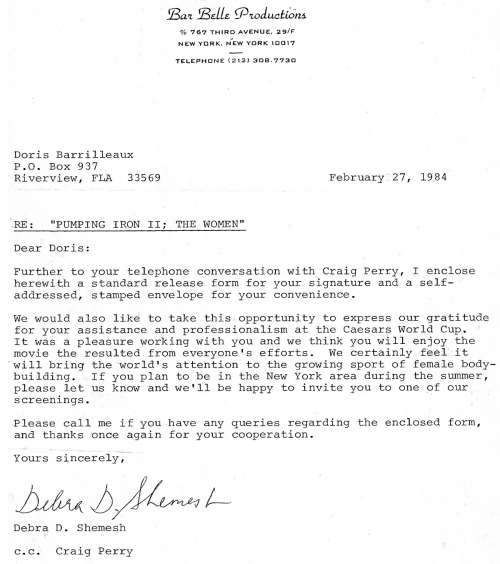
Powerlifter/Bodybuilder, Bev Francis from Australia, the most developed female at this time was invited to compete. She was deliberately numbered to stand beside our first Miss Olympia, Rachel McLish. Fine for showmanship, but when she placed 8th and the rules were suddenly changed to have Bev in the final posedown (IFBB only placed 1-6), I was shocked.
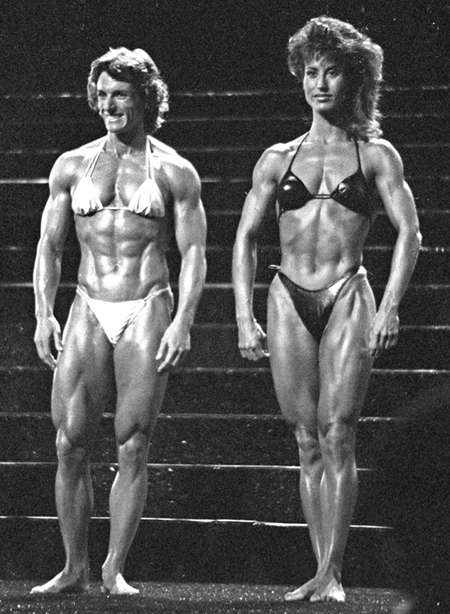
There was already the controversy in the judging. Bev was a very fine person, but obviously ahead of her time as was Laura Combes in our very first Florida contest in 1979. Years later when I asked if she missed competing, Bev said she easily chose motherhood over competition.
I was surprised to be called backstage since I had no connection with the filming. Suddenly, there appeared a dispute about padding in Rachel’s bra. I was the only female qualified to check backstage to help Oscar with this predicament. The rules stated size of a female breast was not supposed to be considered, only the pectoral development. I remember, Deborah Diana, once making a statement that, “no one checked to see if there was any padding in the men’s trunks“.
Here, Doris tells us her opinion of the status of modern female bodybuilding and its different “flavors” (fitness, figure, bikini, physique, bodybuilding) and the never-ending controversy on which way should female bodybuilding be headed to, more muscular or more aesthetic, while informing us about the baby steps taken toward that direction as early as from the very beginning of female bodybuilding contests. An important part of this interview is covered by her experiences as a physique photographer; she shares with us some memorable moments during that aspect of her career. Finally, some words about fitness and aging, on her legacy to the sport as well as some advice directed towards the younger generation of bodybuilders, especially women. Once again, the last part of this interview is accompanied by a large selection of rare and historically important photographic material, a real delight to the eyes of the bodybuilding enthusiast. Much more of such material can be found on her DVD “And-I-Did!”, Vol. 1, that is presented in more detail toward the end of this interview.
On the evolution of female bodybuilding
GRF: You had a very strong and clear vision on how you had imagined female bodybuilding to become. You wanted women to be able to rule what was best for themselves, you thought that we should have two classes, one for the more muscular women, and one for the less muscular, you emphasized on the feminine side and on the art form of the sport. Those exact reasons that made you a pioneer in the sport in the first place, those very reasons were probably the ones that little-by-little had you marginalized from the official IFBB circles and the very sport you had created only a few years later. Later though, (and more than once) the IFBB had issued directives for women bodybuilders to reduce their mass. We also now have five classes (bodybuilding, physique, fitness, figure, and bikini) instead of one or two. How do you feel first of all on how the sport has evolved and which class or classes do you like most? And, do you feel vindicated after 30+ years?
DJB: I saw from the very beginning that there would be a need for two classes. This was before the number of competitors required dividing into weight classes. While at my age of 46 and a grandmother, my own preference was the sculptured, but athletic form such as Deborah Diana, Carla Dunlap etc. However, there were women who wanted to take their development much further. So, I attempted to conduct an experiment at one of the Miami, FL contests about 1980. I convinced promoter, John Mese (now deceased) to have a Bodybuilding and a Body Sculpting Class so I could determine how many women would chose to enter one of these classes. Unfortunately, my other duties required me to be out of the country that weekend. When I returned, I was so disappointed that John had allowed crossovers, totally defeating my purpose. Of course it gave him more entry fees.
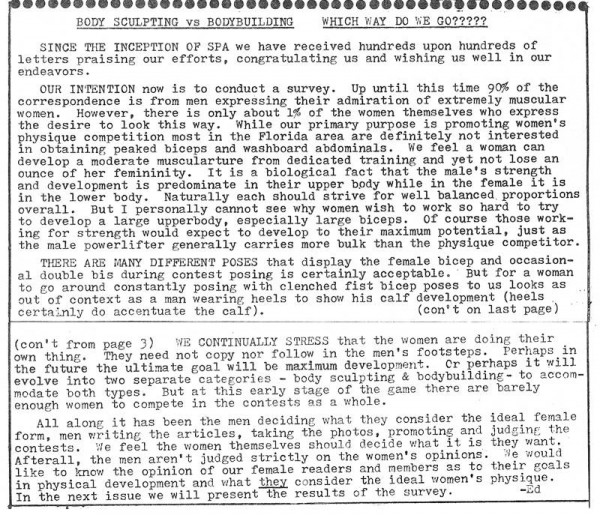
As the competitors grew, so did the classes. We had an Over 35 as did the men. I won that class in the 1980 Ms. Gold Coast.
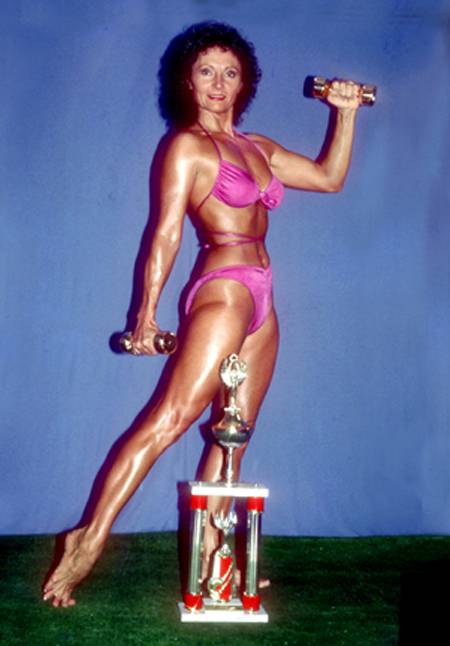
Then came the Fitness where the women could display their Physical Fitness via gymnastics, dance or any medium they chose. This added a bit of spice to the simple flexed posing. Soon it was necessary to divide into Lightweight, Middleweight and Heavyweight. Some were concerned the women would not want to be call Heavy Weight but that was not the case. When the Figure came these were categorized by Height Classes. In 2011, when I was inducted into the National Fitness Hall of Fame at the Arnold Event in Columbus, OH, I was surprised that the men running the sport had added a Bikini Class for anyone off the beach. Not long after this, I learned there had been added a 5th Category “Physique”. If you check out the evolution of women’s bodybuilding you will find that our first SPA contests in 1979 were called, Ms. Brandon Physique, Ms. Tampa Physique and Ms. Florida Physique. What took them so long?
For some time I felt that if you covered the head and could not tell whether the figure was a man or a woman, it had gone too far. After a major competition, I colored the bra on the Heavy Weight woman winner and placed her between the Bantam and Light Weight male winners. This was published in several magazines “What’s Wrong With This Picture”, and hardly a soul noticed.
When Mr. Olympia Frank Zane told me the world wasn’t ready for women bodybuilders in 1978, apparently we had a very different vision in mind. And when Laura Combes (deceased 1989) the winner of Ms. Tampa Physique and I were on the Real People TV show that gave us National recognition in ‘79 she stated, “If people think I’m muscular just wait till you see the women in the future!”
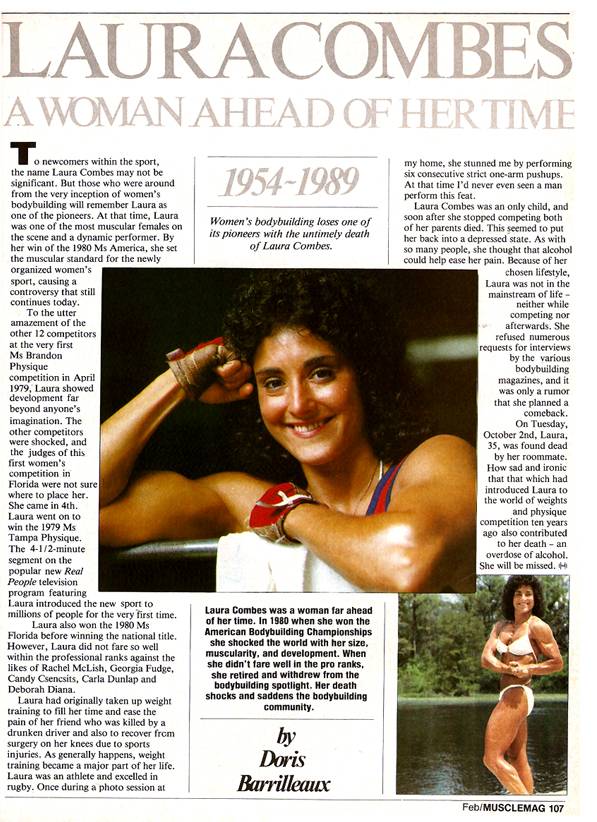
GRF: Indeed, three-time Mr. Olympia Frank Zane once famously told you in 1978, “Doris, the world is just not ready yet for female bodybuilders“. In your opinion, was the world ever ready? Or is there going to be a controversy about that forever?
DJB: I don’t know there was a time table to introduce female bodybuilders. There were famous strong women in the 1800’s like Minerva, Vulcana, and Katie Sandwina (1884-1952; P.T. Barnum claimed her to be the perfect female specimen, nearly 5’10” at 210 lbs.). And at the time there were strong women performing in circuses, vaudeville and music halls.
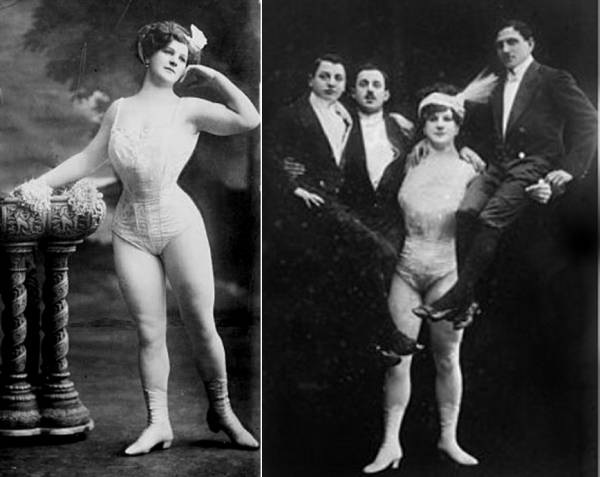
Then in the 1940’s Pudgy Stockton’s (1917-2006: 5’2 at 115 lbs) strength feats on Muscle Beach in California were featured in the magazines I read. Maybe I just happened to come along at the right time to introduce female bodybuilders. I was well aware of the benefits of weight training for women from personal experience in 1956. Since early childhood, I was infatuated with the various actors who played Tarzan. Then came the Hercules actors. The magazines I used to learn about weight training showed such beautiful physical specimens as John Grimek, Steve Reeves, and Frank Zane.
Then by the chance meeting with physique photographer, Dick Falcon in 1976, I took up the hobby of photographing the men’s bodybuilding competitions. There were women working out along side the men in gyms. They were asked to present trophy, but they received no recognition for their accomplishments. Why not? I wasn’t the only one who felt this way. There were women in California like, Lisa Lyon, Kay Baxter, Claudia Wilborn, and Shelly Gruwell. And at the YMCA in Canton, OH, Henry McGee, was training females for competition.
I attribute my determination to rectify this situation after the challenge I felt with Frank Zane’s comment. “Doris, the world’s not ready for women bodybuilders.” I felt that the time had come, and was determined to see that it did. My vision and Frank’s must have been quite different. I wasn’t even aware of steroid enhancement at the time. I thought the women would develop the lines of a strong and shapely athlete. Never did I consider the controversy that arose at our very first SPA 1979 Ms Brandon Physique in Brandon, FL. Rugby player, Laura Combes, refused to disrobe until we entered the stage. Competitors and judges alike were astounded at her muscular development. One male judge placed her 1st where she actually was place 4th by the 3 male and 4 female judges. Another male judge admitted it was difficult to be objective because of his physical attraction to one contestant. It was soon after that I tried my best to offer two different contests Bodybuilder and Body Sculptor, but I was unable to get any support at the time. In order to rectify this situation, various classes were established over the past 30 years, Bodybuilder, Fitness, Figure, Bikini and finally once again Physique. I suppose it’s up to the competitor to choose where she belongs.
On photographer career
GRF: You were a very successful physique photographer for a number of years and the material you must have collected should be enormous. How many years were you active as a photographer, and do you have an estimate about the number of times you have pressed that camera button? Or maybe an estimate on how many bodybuilders you have photographed over the years?
DJB: I began photographing the men’s competitions in 1977 and stopped in 2004, but not by choice. I expected to continue until at least age 80, but due to the introduction of the digital camera I reluctantly retired at 73.
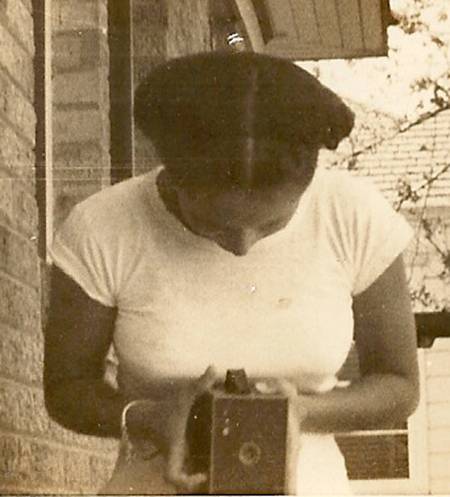
Now, I shoot only digital. The same as with an estimate of the length of my multimedia autobiography AND I DID!, this is not a simple feat. It took me two weeks to time the DVD at 46 hours (not the normal 3.5hr disc limit). I have 21 large file cabinet drawers containing folders of each contest with black and white proof sheets and negatives. Some years I covered as many as 35 contests. The amount of 35mm rolls of 36 depended on the number of contestants. The larger National shows had over 200 competitors. This is not counting color film and bookcases filled with slides. At the 1994 Miss Galaxy I shot over 2,000 slides alone.
I often shot with two cameras, one with black & white film, the other either color or slide film. And when taking photos for covers, I used the third a large 2 1/4″ format camera. To this day, with the simplicity and convenience of digital, I use two of those. I take photos of everything else besides bodybuilders. Just can’t help myself, guess photography is in my blood.
GRF: Could you share with us a memorable photoshoot, where it took place and with whom?
DJB: There were so many beautiful people and places, it’s difficult to pick only one from the hundreds I’ve shot over a 30+ year period.
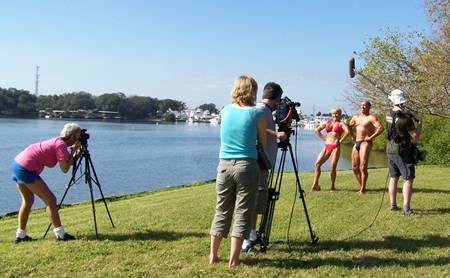
- 1983: In Oslo, Norway, with Georgia Fudge, Deborah Diana, and Carla Dunlap, the sun was already dipping at 3 pm. I convinced the three women to wear their posing suits in a snow covered park assured that I’d get them on a magazine cover. It was so cold my flash batteries froze and so did we.
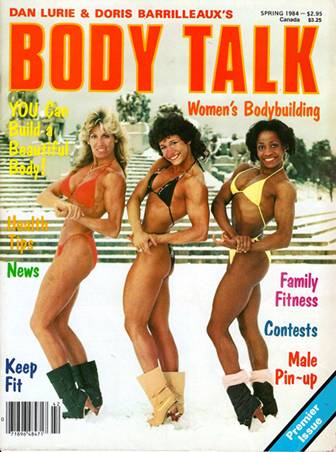
- 1983: Osaka, Japan with, Cathy Chang, and Japan’s Mr. Hercules, Shigru Sugita, in front of an ancient castle.
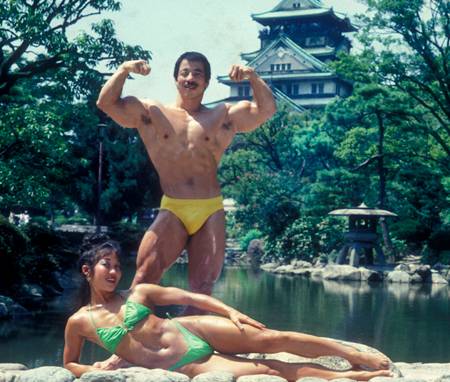
- 1984: Russ Testo and Penny Price. They were having so much fun that when I ran out of film, they asked me to get more from the hotel as they didn’t want to stop the session.
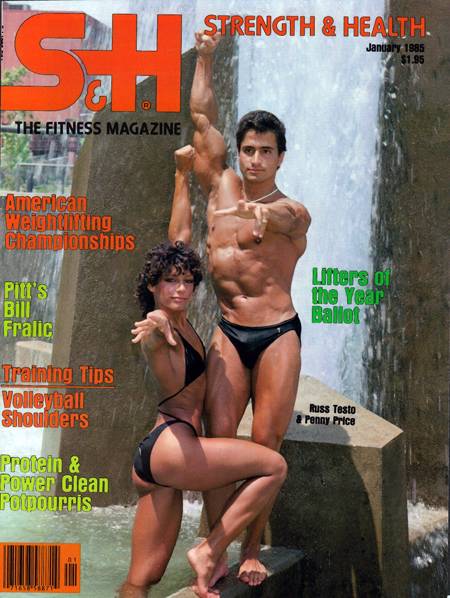
- 1986: In all my years there was only one that proved a bit difficult. A magazine editor assigned me to shoot a couple from Europe for his cover. I’d photographed the man before. This time he refused to move or flex without any explanation. The woman posed around him and we still made the cover.
- 1993: In West Palm Beach, Florida. My group with, Debbie Kruck and Roger Stewart, nearly got arrested posing for pictures in public. We had no idea it was against the law there. Never encountered that before or since.
With one sentence
GRF: Please just one sentence to describe or comment on the following people: John Grimek, Rachel McLish, Laura Combes, Kay Baxter, Carla Dunlap, Georgia Fudge, Kike Elomaa, Cory Everson, Lenda Murray, Deborah Diana, Lee Haney, Arnold Schwarzenegger, Joe Weider, Ben Weider, Oscar State.
DJB:
John Grimek: The perfect specimen of the male physique.
Rachel McLish: A good choice for our first Miss Olympia.
Laura Combes: A bodybuilder ahead of her time.
Kay Baxter: Kay was a good friend, quite muscular for that era who was killed in an auto accident in 1988.
Carla Dunlap: An all round athlete and very articulate.
Georgia Fudge: The first pro in Florida and always in shape.
Kike Elomaa: A worthy Miss Olympia from Finland.
Cory Everson: An athlete before becoming six-time Miss Olympia.
Lenda Murray: We both were inducted to the National Fitness Hall of fame in 2011. I was surprised after the ceremony when she kissed me on the cheek and simply said, “Thank you Doris“.
Deborah Diana: My own choice as the perfect female athlete’s physique.
Lee Haney: A real sweetheart, and eight-time Mr. Olympia
Arnold Schwarzenegger: An icon in bodybuilding and around the world.
Joe Weider: The bodybuilding mogul of the world.
Ben Weider: Head of the IFBB and a Napoleon historian.
Oscar State: Dedicated to many sports and the backbone of the IFBB.
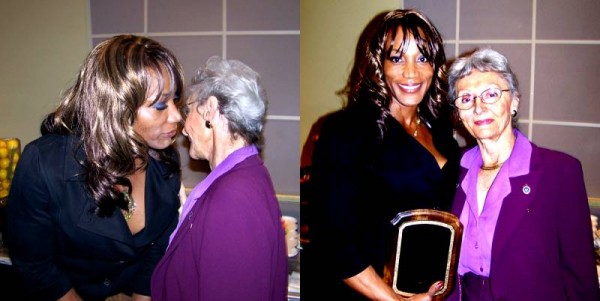
On growing young
GRF: As the years are passing by, one becomes more philosophical about things and puts them in perspective. Currently, you are not only an octogenarian, but a very busy one too. How much do you think that exercising has contributed not only to your longevity, but also to the quality of your life and overall health?
DJB: I fully believe that my dedication to staying physically active plus good genetics makes me who I am today. In a recent TV interview I stated that I thought they made a mistake on my birth certificate. I certainly don’t feel that I’ll be 82this August 11th. Maybe I’m just too hardheaded to accept this fact. I still feel that I’m the same age as most of my friends – mid sixties. Perhaps having always been surrounded with younger people contributes to this feeling as well.
I don’t claim to be exactly the same, but I take no medications, bike daily and swim in the summer. I also believe that my passion for learning new things helps the brain just as exercise does the body. I always do everything myself that I can. I keep my large yard and pool and paint my house inside and out. I see many seniors younger than I that don’t even use a computer. I decided to make my autobiography something more than just pages of text and a few pages of photos as most that I’ve seen. The more I learned to do, the more I wanted to know. I had to learn many different programs including how to transfer old video tapes to disc and then edit them in the computer. I’ve used Photoshop since about 1994 and love working with photos.
When I see young bodybuilders doing things that can damage their bodies and health, I try very hard to impress on them that the long term benefits of taking care of their bodies will pay off in the long run. Some of my trophies have fallen apart by now, but I hope and pray that I have another 20 years left. There is still so much I want and need to do.
GRF: What are the supplements you are still using?
DJB: As I’ve aged, I don’t eat nearly as much as I did. And living alone for 28 years I don’t cook as much either. Therefore, on my own I take a handful of vitamins every day. Maybe it’s overkill, but so far it feels the right thing to do. I take Fish Oil, Calcium, Vitamin B&C, Potassium, Multi-Vitamin, Vitamin E, Glucosamine & Chondroitin, Ginkgo Biloba and low-dose Aspirin. One thing to remember is that each body is different, and what works for one might not work another.
On the “And I Did!” DVD
GRF: Tell us a bit more about your DVD “And I Did!“. What does it contain, and how long did it take you to prepare it? How can people buy it and will there be a “And I Did!, vol. 2“?
DJB: For years many people told me that I should write my autobiography as I’ve led such an interesting life. I kept saying, “I’m too busy living it to stop and write about it.”. Finally, in 2006 I realized that at age, 75, I was the oldest living person in my immediate family. If I didn’t write the history, who would? This took exactly the next five years, Dec. 2006 – Dec. 2011 to complete it. It began strictly for the immediate family. I now have 14 grandchildren and 9 great-grandchildren. Then those from the bodybuilding community began asking when it would be finished. At that point, I had a single 43-page chapter about my bodybuilding involvement. I then began writing about the beginning of women’s bodybuilding and all the adventures I experienced, and the people I met over the next 30+ years. I also had many videos of TV programs and interviews. I wanted to include those as well. I just kept writing until the DVD disc was full. Little did I know that I created something very unique.
It happened that what I did allowed me to get 46 hours of materials instead of the usual 3.5 hours on a normal DVD. John Balik, Editor of IronMan magazine told me, “This has to be a record, I’ve never seen anything like it.” Even my two computer gurus who taught me some of the programs couldn’t believe it. As the old saying goes, “It’s not your grandfather’s Oldsmobile”. By the time I was ready to burn the DVD it contained 159 chapters with thousands of photos, 63 videos and many published newspaper and magazine articles. I realized that I should separate my personal life from the bodybuilding years so it is divided into two sections: Personal and Bodybuilding. The price of this “autographed encyclopedia” is $45.00 US.
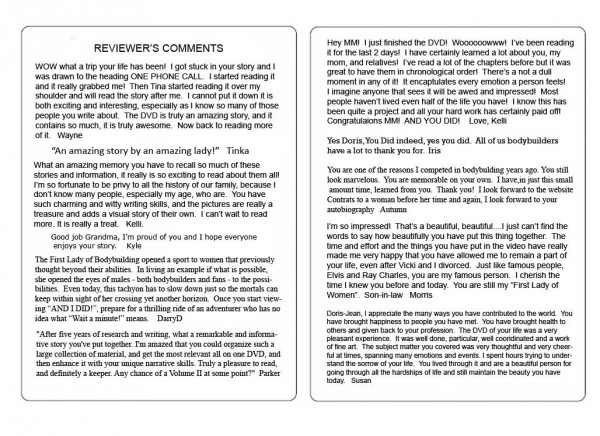 There is no shipping charge within the USA. For anyone interested, I can be reached at The1stLady@juno.com
There is no shipping charge within the USA. For anyone interested, I can be reached at The1stLady@juno.com
At the present time, I’m working to complete Vol II. This will contain all the materials I’ve published and were published about me. It will also contain all my Facebook Post and Photos in a different format much easier to view. And if there remains room, it could possibly contain this interview as well.
On legacy and being an inspiration to the young
GRF: Times are now much different than when you started lifting weights on your own. Do you have any advice for young girls who are now starting (or thinking of starting) with exercise and fitness, etc?
DJB: While basic exercises with free weights are still used, Nautilus and all sorts of new machines have popped up over the years.
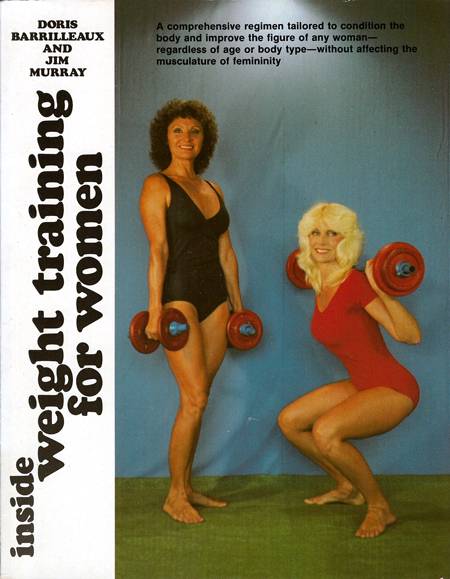
Now there are personal trainers everywhere (Two of my grandsons and a granddaughter are certified personal trainers). I’m afraid I haven’t kept up with all the new techniques like:
- TRX – High Intensity Interval Training.
- ZUMBA – Various dance moves
- BOSU – With half ball and the original
- EXERCISE BALL
I’ve always worked out at home. I bike daily, and swim during the summer. I keep a few dumbbells under the sofa and still do floor exercises during the little time I watch television.
I would hope that many young girls today now are into some kind of sports. There is no longer a stigma about women entering men’s gyms as in the early days. Today there are even female boxers, wrestlers, and race car drivers. I’m so glad that there has been a shift in male and female roles. One example: male flight attendants and female pilots.
Competition is fun and exciting, but I have always warned both males and females that a few broken trophies 25 years later is not worth foolishly damaging their health. For anyone who visits a Nursing Home, it should make them thank the Lord if they have made the right choices concerning their health. I know how thankful I am, and hope to accomplish much more in my lifetime.
GRF: Which are some of the best compliments that you’ve heard from people of the bodybuilding scene?
DJB: After the first Miss Olympia in 1980, Arnold stuck his finger into the cutouts down the side of my yellow evening gown and said, “You gotta be da sexiest grandmutter in da world!” When presenting the 2011 Award for National Fitness Hall of Fame he said, “You deserve it“!
During intermission at a contest in Miami, FL a young African-American approached and asked if I was Doris Barrilleaux. I said Yes. He said, “Do you mind if I give you a hug, I never hugged a legend before.“
A guest poser at a local contest came up to a group of my grandchildren (2 grandsons and a granddaughter had also guest posed and 5 other grandsons sat on front row “test judging”) He said, “Do you all know that your grandmother is a legend?“
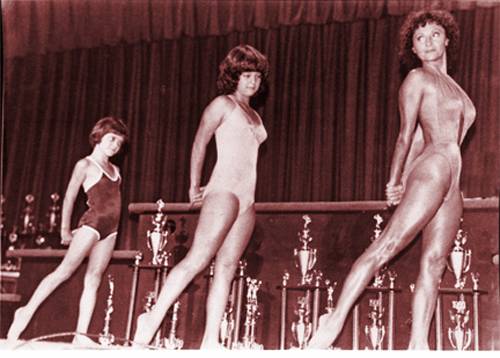
GRF: If you don’t mind me asking, how large has your family become?
DJB: At the moment I have 14 grand and 9 great-grandkids. These are from 2 of my 5 children, my eldest, Vicki, and youngest, Don, (2 sons deceased and daughter with none). And if eldest Brandy had started her family young as we did, I could easily be a great-great grandma. The starred ones are the great-grandkids. Brandy Lynn (1967), Victor Anthony (1971), Anna Leigh (1972), Shilo Eleana (1973), Brandon William (1977), Kelli Rebecca (1979), Michael Dallas (1980), Sterling John (1982), Megan Darlene (1985), Evan Dean (1987), Julian Page (1989), Kyle Ray (1990), Travis Dean (1991), *Dillon Scott (1992), *Hunter Blaine (1993), *Jared Daniel (1998), Hailey Marie (1999), *Kenneth William (2000), *Dalton James (2001), *Madison Paige (2004), *Isaiah William? (2007), *Harrison Dean 10mo (2012), *Todd Burton (2012).

DJB: I never set out to be famous nor a part of history, I discovered the benefits of working out for women as well as men, and spent the last 50+ years of my life pursuing this goal. Later I wanted to show how it had benefited me, and encourage females young and old to follow the lead to be strong, healthy, and independent. I’ve often been told how, at my age, I inspired some of the younger women, and that they look up to me for my strength, determination and independence. I’ve been given many different names: Wonder Woman, Godmother, Queen, etc. But the one that has stuck over these last 35 years is “The First Lady of Bodybuilding”. When eight-time Mr. Olympia, Lee Haney, presented me a copy of his book “Beyond the Pump” in 2011 and it was autographed: “To Our First Lady of Bodybuilding” I finally felt this put the seal on it once and for all.
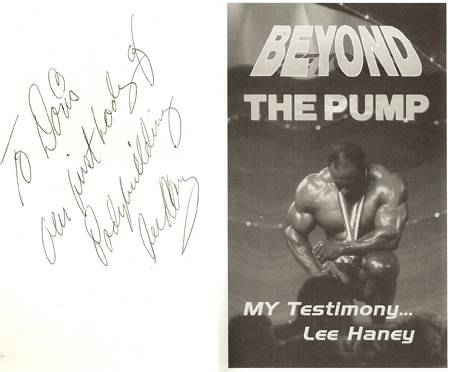
GRF: Dear Ms. Barrileaux, it has been an honor and a pleasure to talk with you. Thank you so much. A final word for the members and friends of our Greek bodybuilding and Fitness website and forum, XBody.gr?
DJB: Thank you for providing the English translation to enjoy all the materials that are covered in XBody.gr. I will share the site with all my friends around the world. It certainly contains a wide variety to satisfy any and all interests and tastes. I am honored that you chose me for the wonderful 3-part interview. I can honestly say that of all my articles, videos, and interviews in the last 30+ years this thorough piece was the best, and my favorite of all time. I am proud to include it with all the others on Vol II of my interactive multimedia autobiography DVD Andidid.com.
“AndI Did!” is a multimedia presentation on the life of Doris Barrilleaux, and how she founded and spearheaded the growth and acceptance of women’s bodybuilding in a DVD based eBook like no other. A multimedia autobiography, comprising 159 chapters and 63 video clips. Length approximately 46 hours of reading and viewing. Includes published magazine articles and newspaper clippings as additional reading. The price of this “autographed encyclopedia” is $45.00 US. There is no shipping charge within the USA. Contact Doris Barrilleaux for information at The1stLady@juno.com.










